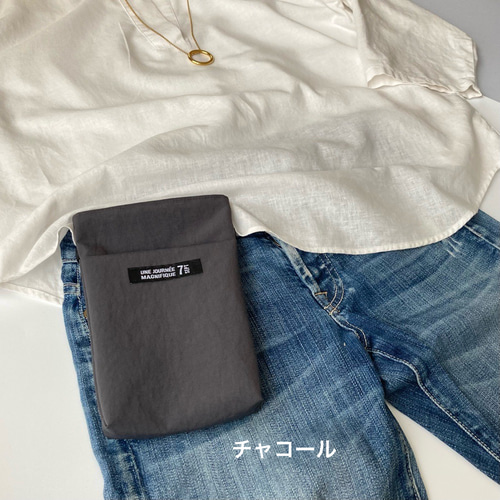移動ポケット チャコール無地⑥ マチあり タグ付き シンプル 男の子 女の子
(税込) 送料込み
商品の説明
☆サイズ☆
縦 約10.5センチ
横 約14.5センチ
底マチ 約2センチ
(多少前後しますがご了承ください。)
無地の生地を使い、ASHIATOYA様のステキなタグをつけた、シンプルな移動ポケットです。
ハンカチなどを入れるポケット1つと普通サイズのティッシュ入れがあります。ティッシュは一枚ずつ取り出せるタイプです。
バンドクリップの取り扱いを始めました。
+120で一組、承ります。
ご希望の方はご購入前にコメント欄より色をお知らせください。
色はグレーと白の2色のみです。
金額変更後のご購入をお願いいたします。
☆色と生地☆
表地・・・くすみチャコール・オックス生地
内側・・・黒・シーチング
ポケット部分・・・黒・オックス生地
【注意事項】
★一つ一つ丁寧を心掛けて製作していますが、家庭用ミシンで作る素人のハンドメイドです。多少のズレや歪み、糸処理の甘さ等があります。
お店で販売しているような完璧品ではございませんので、ご理解頂いた上で、ご購入をお願いいたします。
★画像では100%同じお色を表現することが出来ておりません。環境により実際のお色味と異なる場合がございます。
★チャコペンの跡が付いている場合がありますが、お洗濯で消えるチャコペン、又は時間経過で消えるペンを使っております。
★定形外郵便での発送です(追跡機能なし)。+料金でメルカリ便への変更を承ります。
おまとめ割引あります。2点購入で50引き、3点購入で引かせていただきます。
メルカリ便への変更やおまとめをご希望の際は、購入前にコメント欄よりお知らせください。
おまとめ3点以上はメルカリ便で発送させていただきます(+料金なし)。
★ご不明な点やご質問がありましたら、お気軽にお問い合わせください。
種類...移動ポケット
柄・デザイン...無地商品の情報
| カテゴリー | ハンドメイド・手芸 > ベビー・キッズ > 手提げ・レッスンバッグ・入園グッズ |
|---|---|
| 商品の状態 | 新品、未使用 |

移動ポケット 無地 シンプル グレー 男の子 女の子 マチ付き 大きめ

移動ポケット 無地 シンプル グレー 男の子 女の子 マチ付き 大きめ

移動ポケット くすみチャコール無地⑤ マチあり タグ付 シンプル

移動ポケット 無地 シンプル グレー 男の子 女の子 マチ付き 大きめ

移動ポケット 無地 シンプル グレー 男の子 女の子 マチ付き 大きめ

移動ポケット くすみチャコール無地⑤ マチあり タグ付 シンプル

移動ポケット 無地 シンプル グレー 男の子 女の子 マチ付き 大きめ

移動ポケット シンプル マチなし キャンプ ☆クリップ付 - その他

移動ポケット 無地 シンプル グレー 男の子 女の子 マチ付き 大きめ

楽天市場】【楽天ランキング1位受賞】移動ポケット 男の子 移動

移動ポケット 無地 シンプル グレー 男の子 女の子 マチ付き 大きめ

移動ポケット 無地 ピンク シンプル 男の子 女の子 マチ付き 大きめ

移動ポケット 黒 無地 タグ ① 男の子 女の子 クリップなし
移動ポケット 小学校 男の子 女の子 クリップ 日本製 デニム 無地 マルチポケット クリップポーチ 入学祝 入園祝 保育園 幼稚園 小学生 プレゼント/送料無料 : mz1061 : ミ・エストン - 通販 - Yahoo!ショッピング

移動ポケット 黒 無地 タグ ① 男の子 女の子 クリップなし

移動ポケット 細ストライプ④ マチあり シンプル 男の子 女の子 - ベビー

移動ポケット 黒 無地 タグ ① 男の子 女の子 クリップなし

楽天市場】移動ポケット 女の子 男の子 ショルダー クリップ 2way

移動ポケット くすみチャコール無地⑤ マチあり タグ付 シンプル

移動ポケット 無地 ピンク シンプル 男の子 女の子 マチ付き 大きめ

移動ポケット シンプル マチなし キャンプ ☆クリップ付 - その他
移動ポケット 移動ポーチ ポシェット ポーチ ポケットバッグ 送料無料 便利でオシャレ 底マチ付き '24新作入荷 女児 女の子 男児 男の子 キッズ

移動ポケット 無地 ピンク シンプル 男の子 女の子 マチ付き 大きめ

移動ポケット シンプル マチなし キャンプ ☆クリップ付 - その他

移動ポケット 無地 シンプル グレー 男の子 女の子 マチ付き 大きめ

楽天市場】移動ポケット OCEAN&GROUND 女の子 クリップ 男の子
移動ポケット 移動ポーチ ポシェット ポーチ ポケットバッグ 送料無料

移動ポケット 黒 無地 タグ ① 男の子 女の子 クリップなし

移動ポケット 無地 ピンク シンプル 男の子 女の子 マチ付き 大きめ

楽天市場】移動ポケット OCEAN&GROUND 女の子 クリップ 男の子

移動ポケット シンプル マチなし キャンプ ☆クリップ付 - その他
移動ポケット 移動ポーチ ポシェット ポーチ ポケットバッグ 送料無料

移動ポケット 無地 シンプル グレー 男の子 女の子 マチ付き 大きめ
移動ポケット 移動ポーチ ポシェット ポーチ ポケットバッグ 送料無料

楽天市場】【楽天ランキング1位受賞】移動ポケット 男の子 移動

移動ポケット シンプル マチなし キャンプ ☆クリップ付 - その他

撥水 フタなし マチつき ⭐︎ 大人の シンプル 移動ポケット ⭐︎ 軽い

幼稚園用】ハンカチティッシュを忘れない!男の子用移動ポケットの

楽天市場】移動ポケット PUMA プーマ 男の子 マルチポケット クリップ
移動ポケット 小学校 男の子 女の子 クリップ 日本製 デニム 無地






商品の情報
メルカリ安心への取り組み
お金は事務局に支払われ、評価後に振り込まれます
出品者
スピード発送
この出品者は平均24時間以内に発送しています














